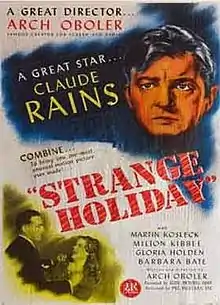Strange Holiday (1945 film)
Strange Holiday is a 1945 American movie directed by Arch Oboler. Claude Rains features as a man who returns from a fishing vacation to find America controlled by fascists.
| Strange Holiday | |
|---|---|
 Theatrical poster for the film | |
| Directed by | Arch Oboler |
| Written by | Arch Oboler (radio play and screenplay) |
| Starring | Claude Rains |
| Cinematography | Robert L. Surtees |
| Edited by | Fred R. Feitshans Jr. |
Production company | Elite Pictures General Motors |
| Distributed by | Producers Releasing Corporation |
Release date |
|
Running time | 61 minutes |
| Country | United States |
| Language | English |
Introductory material included with the video release of this movie states that it was underwritten by General Motors corporation and was shown initially in private screenings for the corporation's employees.
Martin Kosleck, a German actor who had played a Nazi or Nazi sympathizer in numerous American movies during the Second World War, is featured prominently as a local authority of the new oppressive regime. The new government makes prominent and continual use of an emblem consisting of two crossed swords over two fascist bundles (a bundle of rods with an axe: the pre-Nazi symbol for fascism) in much the way the Swastika had been employed by Nazi Germany.
Plot
The story is told in flashback from Stevenson being tortured in a chair, reflecting how he got there.
We see Stevenson and three children decorating the Christmas tree on Christmas Eve: a picture of normality.
Then, he is flying in his friend's small plane to a fishing and camping holiday with an old friend in a remote area. Afterwards, they head home on Friday the 13th. Flying back, the plane develops problems and they crash-land in a field in a remote location. At the farmhouse, the farmer refuses to let them in and use the phone. A truck driver also acts oddly but gives Stevenson a lift into his town for $20. The driver also declines to explain his hostile behaviour. The main street is devoid of people, but then he meets Miss Simms, his secretary, but she does not want to talk. When he goes to his office, it is deserted. He meets the building manager, Regan, who says they thought he was dead, but will not explain why the business is not operating.
Stevenson goes to his house and cannot find his wife and children there. Then two men grab him and when he refuses to go with them he is coshed. He revives in jail where another prisoner gives him water and tells him the American Constitution has been changed by those now in charge. He is called to an examiner to explain where he has been and who he has met. He is refused a lawyer. They tie him to a table and beat him. The examiner then explains the new America: no religion; no free speech; punishment for non-conformity. Stevenson is declared an enemy of the state. In his cell, he ponders on this new world order. When he sleeps, he dreams of an alternative future and sees a picnic with another family: his daughter has grown up and is being courted. When he wakes, he decides he does not want to keep living in this new world.
The scene then fades out to Stevenson waking from a nap while still camping with his friend. The whole thing was a bad dream.
Cast
- Claude Rains as John Stevenson
- Bobbie Stebbins as John Stevenson Jr.
- Barbara Bates as Peggy Lee Stevenson (credited as Barbara Bate)
- Paul Hilton as Woodrow Stevenson Jr.
- Gloria Holden as Mrs. Jean Stevenson
- Milton Kibbee as Sam Morgan
- Walter White Jr. as Farmer
- Wally Maher as Truck Driver
- Tommy Cook as Tommy, the Newsboy
- Griff Barnett as Regan
- Ed Max as First Detective
- Paul Dubov as Second Detective
- Helen Mack as Miss Simms his Secretary
- Martin Kosleck as Examiner
- Charles McAvoy as Guard
- Priscilla Lyons as Betty
- David Bradford as Boy Friend
- Uncredited African American actor as "Nobody", a prisoner
External links
- Strange Holiday at IMDb
- Strange Holiday at AllMovie
- Strange Holiday at the TCM Movie Database
- Strange Holiday at the American Film Institute Catalog
- Review of film at Variety
- Review of film at New York Times